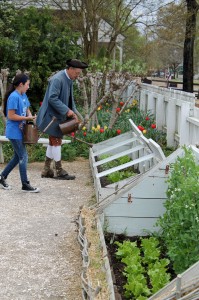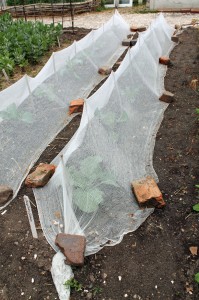Lessons of Our Foregardeners
April 23rd, 2013
I’m just back from a garden trip to Virginia, where the season is a good 2 weeks ahead of ours.
They’re in our May mode already with azaleas and viburnums in full bloom, tree pollen coating cars yellow, and even the first few ‘Knock Out’ rose flowers poking out.
One of my stops took me to Colonial Williamsburg, where I got to meet garden historian Wesley Greene, author of one of my favorite gardening books of 2012 – “Vegetable Gardening the Colonial Williamsburg Way” (Rodale Books, $30).
Greene founded Williamsburg’s Colonial Nursery on Duke of Gloucester Street and still works there, spending most days showing visitors how our foregardeners grew their food.
The place is a cross between an 18th-century vegetable demo garden and a garden center with Colonial-era plants, seeds and gardening paraphernalia.
I ran into Greene next to the purple Roman broccoli, a multi-shoot type that he says isn’t plagued by annoying cabbageworms nearly so much as our modern green-headed broccoli hybrids. It’s a good-looking plant in the garden, too.
Greene gardens here like it’s 1760 – using rotted manure to build the soil and hand-carried water from a barrel (no hoses in those days).
I’m always fascinated by this place and by how people grew their food 250 years ago.
They were actually very clever.
You know that cutting-edge, spun-bonded polyester floating row cover that we drape over our plants for bug protection?
Colonials were doing the same thing centuries ago, using cheese cloth.
And you know how we buy mini plastic-domed greenhouses, Wall o’ Waters and other gizmos to get a jump on the season?
Colonial gardeners beat us to that idea, too, by using oiled paper instead of plastic and covering their tender plants on frosty nights with glass cloches (bell-shaped jars).
Greene has lettuce ready to pick and peas in flower already inside one particularly interesting cold-frame contraption.
This box stays extra toasty thanks to a layer of insulating straw secured with woven branches around the cold frame’s wooden sides. A glass window frame covers the top as needed, and a layer of composting manure adds warmth under the soil.
I like the fencing and supports in this garden, too.
All of it comes from tree and shrub branches. Shorter ones are interwoven to make a knee-high edging around some of the beds, while the longer ones are strapped together to make 6-foot-tall tripods and vertical supports for vining crops.
We can learn a lot from this garden.
What worked then works now – and is often cheaper and more environmentally friendly.
Funny how heirloom varieties and chemical-free vegetable gardening are so chic now, yet that was just the way everybody did it back then.
“That the future may learn from the past.”
Colonial Williamsburg’s founder, John D. Rockefeller Jr., spelled out that motto from the beginning, and it still rings true in the Colonial Nursery.
Yet places like Colonial Williamsburg are struggling to stay relevant to today’s visitor.
Greene shared that he’s fortunate his career happened when it did because he’s not so sure someone else will be doing this in the future.
Adults seem to prefer casinos and cruises these days to museums and historical attractions.
And the lifeblood of tomorrow – today’s youth – is more likely to pick nearby Busch Gardens or Disneyworld for a vacation unless parents go back to doing the deciding.
When the Weigel kids were little, we had them to Williamsburg no fewer than eight times.
They loved it and got a healthy dose of education and enrichment in disguise every visit.
I usually don’t tell people what to do, but if you’ve got kids or grandkids, take them.
See the Colonial Nursery.
Have them spend a few minutes with Wesley Greene.
Let them see what cardoon and kohlrabi look like (not to mention perukes and hand-made bricks).
Check out the rest of the wonderful gardens and living history while you’re there.
It’s a 5-hour drive that’ll take you 250 years back in time. And your support will help make it possible for the future to learn from the past.










